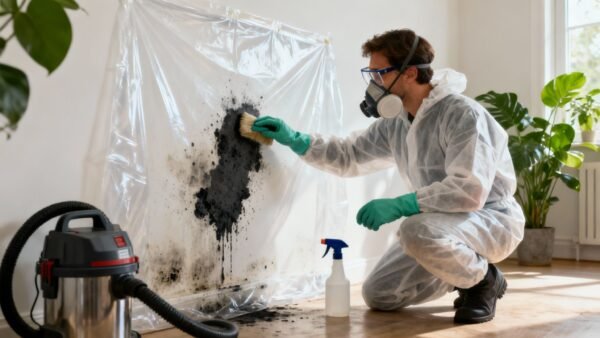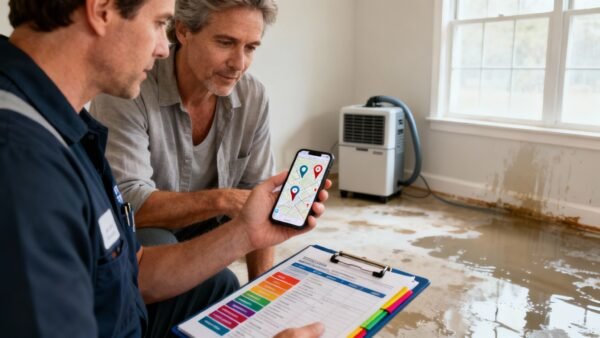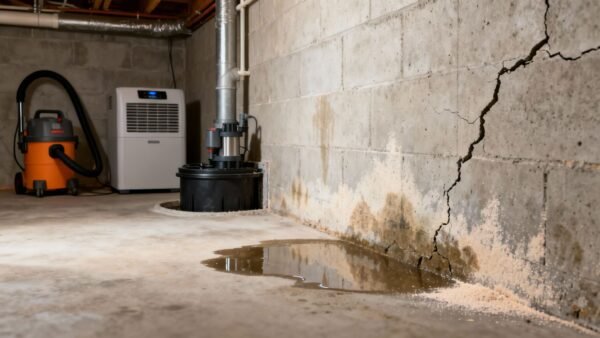Finding mold in your Los Angeles home is more than just an unsightly problem; it’s a serious issue that demands immediate, professional attention. A professional mold remediation service isn’t just about cleaning what you see. It’s a highly controlled process designed to eliminate mold at its source, restore healthy air quality, and ensure it doesn’t return. Think of it less as a simple cleanup and more as a scientific mission to restore your property to a safe, healthy state.
Ignoring a small patch of mold, especially in areas prone to dampness like a Sherman Oaks basement after heavy rains or a Santa Monica bathroom with constant coastal fog, can lead to widespread contamination. This is where a professional mold remediation service becomes essential.
The Difference Between Cleaning and Remediation
Many homeowners’ first instinct when they see a mold spot is to grab a bottle of bleach and start scrubbing. While it feels productive, it’s often the worst thing you can do. This approach is like putting a band-aid on a deep wound—it hides the symptom but does nothing about the underlying moisture issue that allowed the mold to grow in the first place.
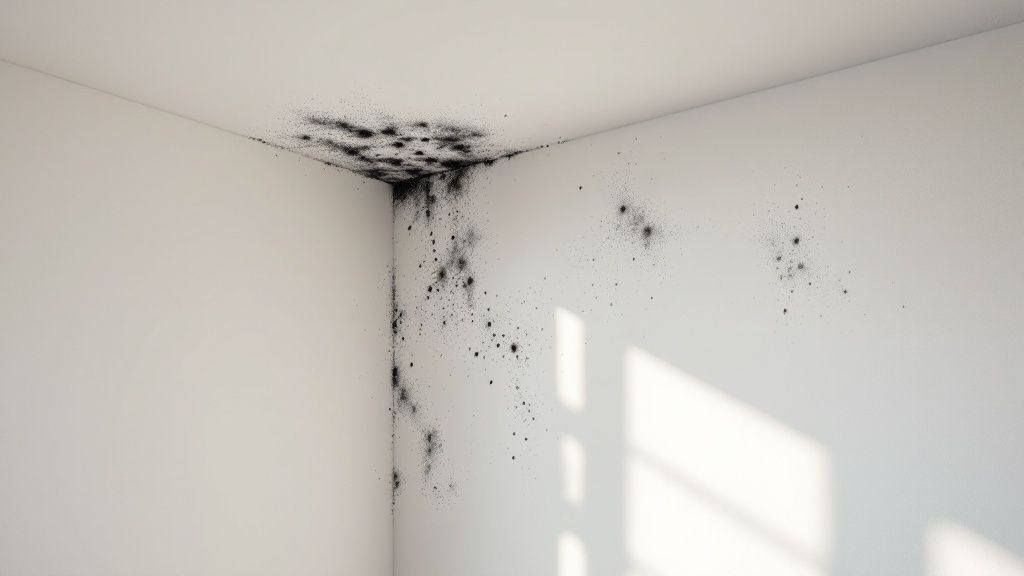
Worse yet, scrubbing a mold colony can disturb it, launching millions of microscopic spores into the air. These spores then travel through your HVAC system and land in new areas, turning a small, localized problem into a widespread infestation that can affect your entire property.
True mold remediation service is a methodical, surgical procedure for your home. Certified technicians don’t just wipe surfaces. They find the moisture source feeding the mold, set up containment to prevent cross-contamination, and safely remove compromised materials like drywall, carpet, or insulation.
DIY Cleanup vs Professional Mold Remediation Service
It’s tempting to try and handle a small mold issue on your own, but it’s crucial to understand the difference in scope and safety between a DIY attempt and a professional service.
| Aspect | DIY Cleanup | Professional Remediation Service |
|---|---|---|
| Scope | Addresses only visible surface mold. | Identifies and corrects the moisture source, removes hidden mold. |
| Safety | High risk of spreading spores and personal exposure. | Uses full PPE, containment, and negative air pressure. |
| Equipment | Household cleaners, cloths, and maybe a fan. | HEPA air scrubbers, industrial dehumidifiers, antimicrobial agents. |
| Effectiveness | Often temporary; mold usually returns. | Aims for permanent removal and prevents regrowth. |
| Verification | No way to confirm all spores are gone. | Uses post-remediation testing to verify success. |
While DIY might seem like a quick fix for a tiny spot, anything larger than a few square feet demands a professional’s expertise to ensure the problem is truly solved.
Key Goals of Professional Remediation
The ultimate goal isn’t just to make the area look clean. It’s to make the environment structurally sound and completely safe for everyone inside. This is accomplished through a multi-step process:
- Identify and Correct the Moisture Source: This is the absolute first step. Without fixing the leak, high humidity, or condensation issue, the mold will just grow back.
- Isolate the Contaminated Area: Professionals use thick plastic sheeting and negative air pressure machines to create a sealed work zone. This containment ensures that no mold spores can escape and spread to other parts of your property during the removal process.
- Remove Contaminated Materials: Porous materials like drywall, insulation, and carpet that are heavily infested can’t be saved. They are carefully cut out, double-bagged, and disposed of according to strict industry regulations.
- Clean and Sanitize: Non-porous surfaces (like wood studs or concrete) are cleaned with powerful antimicrobial agents. Then, commercial-grade HEPA (High-Efficiency Particulate Air) air scrubbers are run for days to filter any lingering airborne spores out of the air.
This is why a detailed inspection is non-negotiable. To truly understand the scope of the problem, a professional will often recommend mold testing to identify the types and concentration of mold you’re dealing with. That data becomes the roadmap for the entire remediation strategy, making sure the job is done right the first time.
The Hidden Dangers of Ignoring Mold Growth
That dark spot on the wall or that stubborn musty smell you can’t seem to air out? It’s more than just an ugly nuisance. Think of it as a warning flare signaling a serious threat to both your home and your family’s health.
Ignoring mold allows it to quietly wreak havoc, compromising your property’s structure and your well-being. This is why a professional mold remediation service isn’t a luxury—it’s an essential investment.
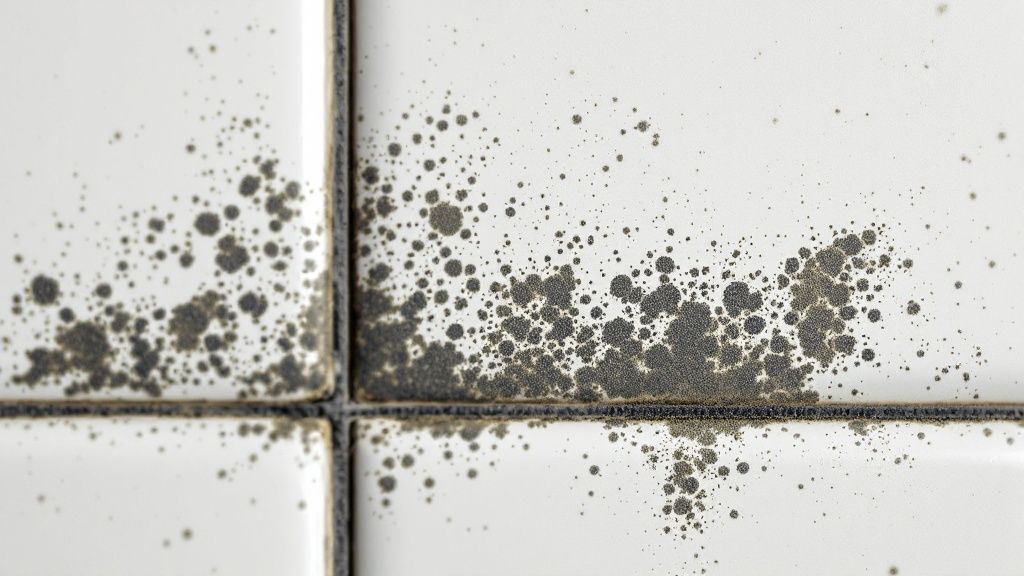
Mold isn’t a passive stain; it’s an active organism. It literally eats your house for breakfast, lunch, and dinner. The organic materials that make up your home—drywall, insulation, wood beams, and subflooring—are its food source.
Over time, this feeding process leads to decay, weakening your home’s framework and setting you up for thousands of dollars in structural repairs. A small, unchecked leak from a flat-roof home in the Valley can quickly escalate, especially when there’s hidden mold behind walls, which can silently destroy your home’s integrity. For more on this, check out our guide on finding hidden mold behind walls.
Health Risks Linked to Mold Exposure
Beyond the damage to your property, the most immediate danger is in the very air you breathe. As mold colonies grow, they release microscopic spores that become airborne and circulate through your HVAC system.
Breathing in these spores can trigger a whole host of health issues, especially for the most vulnerable: children, the elderly, and anyone with existing respiratory conditions.
Common health problems tied to mold exposure include:
- Persistent Allergies: Symptoms like sneezing, itchy eyes, and a runny nose that just won’t quit.
- Worsened Asthma: More frequent and severe asthma attacks.
- Respiratory Issues: A chronic cough, wheezing, or shortness of breath.
- Headaches and Fatigue: Unexplained headaches and a feeling of constant tiredness that seems to lift when you leave the house.
This growing awareness of the health risks is what’s pushing property owners to finally call in the pros. In fact, in 2023, North America led the market for mold remediation, a trend driven by stronger regulations and homeowners who are more conscious of their health than ever before.
The longer you let mold sit, the greater the risk. What starts as a minor inconvenience can snowball into a major health crisis, turning your home from a sanctuary into a source of chronic illness. A proactive approach is the only way to safeguard your family and your property.
The Professional Mold Remediation Process Step by Step
A professional mold remediation service is a lot more than just cleaning up. Think of it as a systematic, multi-stage operation designed to not only get rid of the current mold but also to make sure it doesn’t come back. Understanding how the pros handle it helps demystify the process and shows why you can’t just spray it with bleach and call it a day.
Every single step is performed with precision, because when it comes to mold, thoroughness and safety are everything. It all starts with a detailed assessment—and I don’t mean a quick glance. This is a full-blown investigation into your home’s health.
Step 1: Inspection and Damage Assessment
Before a single tool comes out, certified technicians have to figure out the full scope of the problem. They use tools like moisture meters and thermal imaging cameras to hunt down the water source that’s feeding the mold. This is the most important part—if you don’t stop the water, the mold will just return.
They also map out how far the contamination has spread. It’s common to find mold hiding behind walls or under flooring, completely out of sight. This initial phase creates the strategic roadmap for the entire project. For a deeper dive, check out our ultimate guide to mold inspections.
Step 2: Containment of the Affected Area
Once the team knows what they’re dealing with, the immediate priority is to stop the mold from spreading to other parts of your home. Technicians set up a containment zone using thick plastic sheeting and specialized tape, effectively sealing off the contaminated area from the rest of the house.
To prevent cross-contamination, they create negative air pressure inside the contained area. This is done with powerful fans that vent air outside, ensuring that any mold spores kicked up during removal are captured and safely exhausted, not circulated through your HVAC system.
Step 3: Advanced Air Filtration and Removal
With the area sealed off, the air itself needs to be purified. High-efficiency particulate air (HEPA) scrubbers are brought in and run continuously to capture microscopic mold spores floating in the air.
At the same time, technicians begin the careful removal of any contaminated porous materials—think drywall, insulation, and carpeting. These items are impossible to clean completely, so they have to be carefully bagged and disposed of according to strict environmental regulations.
This infographic breaks down these critical first stages, showing just how methodical the workflow really is.
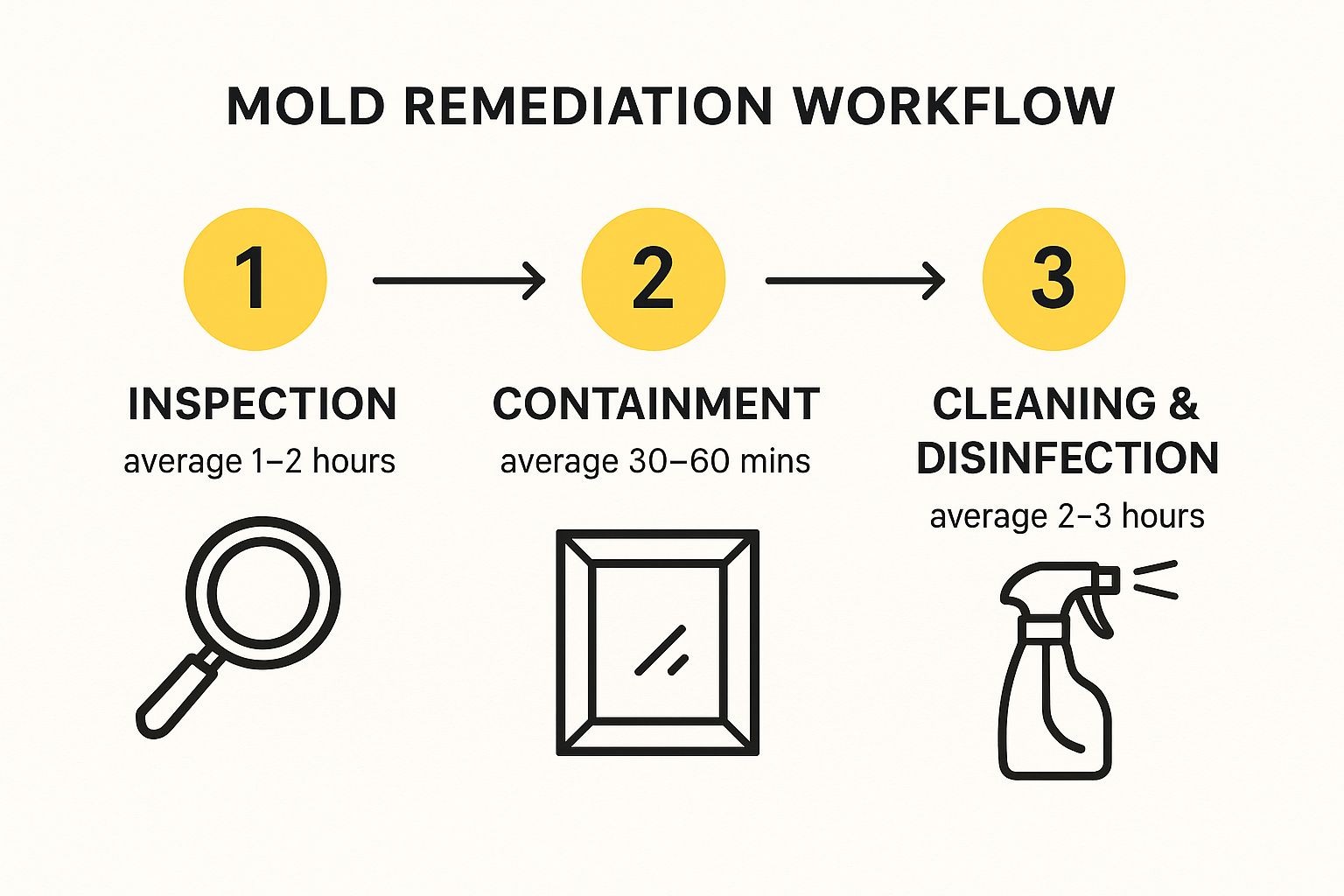
As you can see, each step builds on the last. It’s a controlled process from start to finish.
Key Takeaway: A professional mold remediation service is a controlled process. From isolating the area to filtering the air, every action is designed to eliminate the current threat while protecting the rest of your property from exposure.
Step 4: Cleaning, Sanitizing, and Restoration
After all the contaminated materials are gone, the job isn’t over. Every remaining surface, like wood studs, concrete slabs, and even personal belongings that can be salvaged, is meticulously cleaned with antimicrobial agents. This kills any lingering mold and helps prevent it from growing back.
Finally, the area is prepped for restoration. This is where your home starts to look like itself again. It might involve putting up new drywall, painting, and reinstalling flooring to return your home to its pre-loss condition, making it both safe and structurally sound once more.
Understanding the Cost of a Mold Remediation Service
Figuring out the price of a professional mold remediation service isn’t as simple as looking up a number in a catalog. The final cost is a detailed calculation based on several critical factors, which is why it’s so important for homeowners to understand what actually drives the price. It’s best to see the service as a long-term investment in your property’s health and safety, not just another bill to pay.
Use Our Mold Remediation Cost Calculator
At its core, the cost is tied directly to the scale and complexity of the contamination. Think about it: a small, easy-to-reach patch of mold on a bathroom wall is going to cost a lot less to handle than a widespread infestation hidden deep inside an attic or crawlspace.
Key Factors That Influence Pricing
When a professional comes out to give you an estimate, they’re not just pulling a number out of thin air. They’re assessing several key variables, and knowing what those are will help you compare quotes and recognize a thorough, honest assessment.
- Size of the Affected Area: This is the big one. The total square footage of contamination is the primary cost driver because a larger area simply requires more labor, more containment materials, and more equipment to do the job right.
- Location and Accessibility: Mold hiding in a cramped, hard-to-reach crawlspace or behind a maze of plumbing requires far more intensive labor and specialized containment strategies than mold growing on an open basement wall. The tougher it is to get to, the more it will cost.
- Type of Contaminated Materials: Getting mold off non-porous surfaces like concrete is relatively straightforward. But porous materials are a different story. Things like drywall, insulation, and carpeting often can’t be salvaged and need to be completely removed and replaced, which adds to the project’s overall cost.
- Level of Contamination: There’s a huge difference between a light dusting of surface mold and a deeply embedded infestation that has started to compromise structural materials like wood framing. The deeper the problem, the more intensive—and expensive—the solution.
The mold remediation service sector is a key part of the larger restoration industry, which in the United States alone was valued at approximately USD 7.1 billion in 2025. This growth isn’t surprising; it shows that more people are understanding the massive long-term costs of simply ignoring a mold problem.
Ultimately, any detailed estimate from a reputable company should clearly break down these costs for you. For a personalized idea of what your project might involve, you can use our mold remediation cost calculator to get a preliminary estimate based on your specific situation. This kind of transparency ensures you know exactly what you’re paying for—a complete and lasting solution to your mold problem.
How to Choose the Right Mold Remediation Company
Picking the right team for mold cleanup is hands down the most important decision you’ll make in this whole process. A great mold remediation service doesn’t just get rid of the mold; they give you back your peace of mind and protect your home’s value. But with so many companies out there, how do you tell the real pros from the rest?
It all starts with checking their credentials. Never, ever hire a company that isn’t properly licensed and fully insured. Ask to see proof of their general liability and workers’ compensation insurance. This is non-negotiable—it protects you from being on the hook if an accident happens on your property during the job.
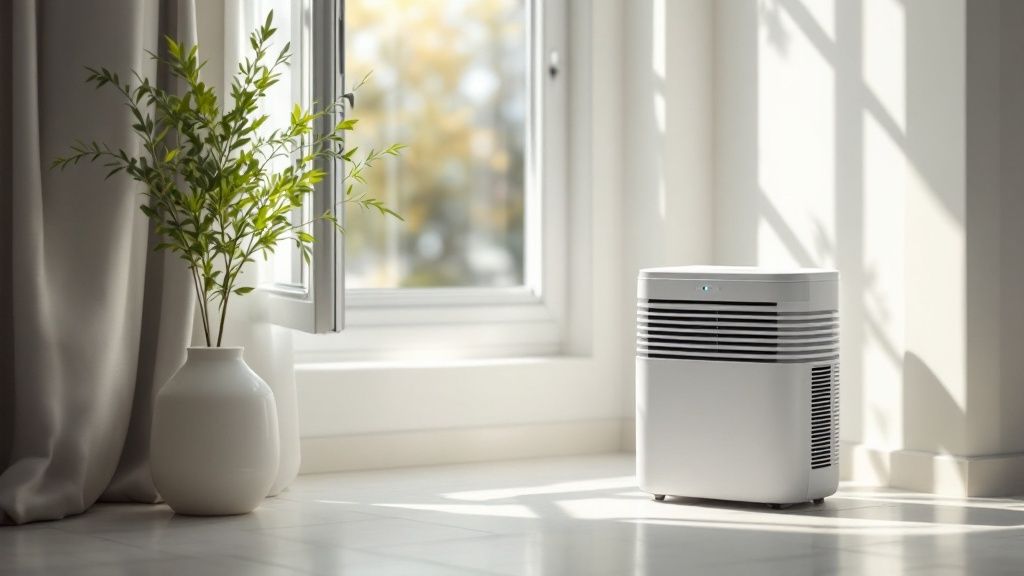
Look for Industry Certifications
Beyond the basics, you want to see certifications from the Institute of Inspection, Cleaning and Restoration Certification (IICRC). Think of this as the gold standard in our industry. When a firm is IICRC-certified, it means their technicians have been properly trained on the latest, safest, and most effective remediation methods.
This kind of specialized training is critical. As mold-related health issues like respiratory problems and allergic reactions become more common, the demand for true expertise has skyrocketed. You can read more about the growing mold removal services market to get a sense of why hiring a certified expert is so important.
Red Flags and Questions to Ask
Be skeptical of any company that tries to scare you into a quick decision or throws out a super-low price without even doing a proper inspection. A lowball offer is often a sign they’re planning to cut corners on vital steps like containment or air filtration, which could leave you with a bigger problem than you started with.
To really vet a company, make sure you ask these questions:
- Can you provide a detailed, written estimate that outlines the entire scope of work?
- What is your process for containing the area to stop mold from spreading?
- Do you perform post-remediation testing to prove the job was done right?
- Can you share references from a few recent clients?
A trustworthy company will be happy to answer your questions and will want you to feel confident in their plan. Their goal should be to educate you, not just sell you. Choosing the right mold remediation service is an investment in a safe, healthy home for the long haul.
Frequently Asked Questions About Mold Remediation Service
Even with a good grasp of the process, it’s natural to have questions about what a professional mold remediation service actually involves. Getting straight answers is the best way to feel confident about protecting your property. Let’s tackle some of the most common questions we hear from homeowners.
Q: How long does mold remediation usually take?
A: This really depends on the size of the job. A small, self-contained mold problem, like under a bathroom sink in a Beverly Hills home, can often be handled in just 1-3 days. But if you’re dealing with a more serious situation—say, widespread mold in an attic, basement, or hidden inside walls—it could easily take a week or longer. Extensive projects often require significant repairs after the mold is gone, which adds to the timeline. Your initial inspection is where you’ll get a solid, customized timeline.
Q: Is it safe to stay in my house during remediation?
A: For minor jobs that can be completely sealed off, you might be able to stay in an unaffected area of your home. However, safety always comes first. For larger projects, or if anyone in your family has asthma, allergies, or a compromised immune system, we’ll almost always recommend relocating for a few days. This guarantees no one is exposed to airborne spores or contaminants during the cleanup.
Q: Does homeowners insurance cover mold remediation?
A: This is a tricky one, as coverage depends entirely on your specific policy and what caused the mold in the first place. If the mold grew because of a “sudden and accidental” covered event, like a pipe bursting, your insurance will likely cover it. On the other hand, mold that results from slow leaks, high humidity, or general lack of maintenance is almost never covered. The best move is to pull out your policy and call your insurance agent to confirm.
Q: Will the mold come back after remediation?
A: The whole point of professional remediation is to make sure it doesn’t come back. A proper job doesn’t just clean the mold; it fixes the moisture source that allowed it to grow. As long as the leak, condensation, or ventilation issue is permanently repaired, the mold has no fuel to return. Reputable companies will stand by their work. If you’re ever worried about a spot you see, our guide on how to know if it’s mold can help you figure out what you’re looking at.
Q: What should I do if I find mold behind drywall?
A: Do not attempt to remove the drywall yourself, as this can release a high concentration of spores into your home. Immediately stop using the area, seal any vents, and contact a licensed restoration company to assess the risk. Mold often spreads far beyond the initially visible spots.
Q: Can you just paint over mold?
A: No, painting over mold is a temporary and ineffective fix. While it may cover the stain, the mold will continue to grow underneath the paint, eating away at the drywall or wood. The underlying moisture problem must be fixed and the mold must be professionally removed before any repainting occurs.
Ready to ensure your property is safe and mold-free? The expert team at Onsite Pro Restoration is here to provide a thorough, professional mold remediation service.


